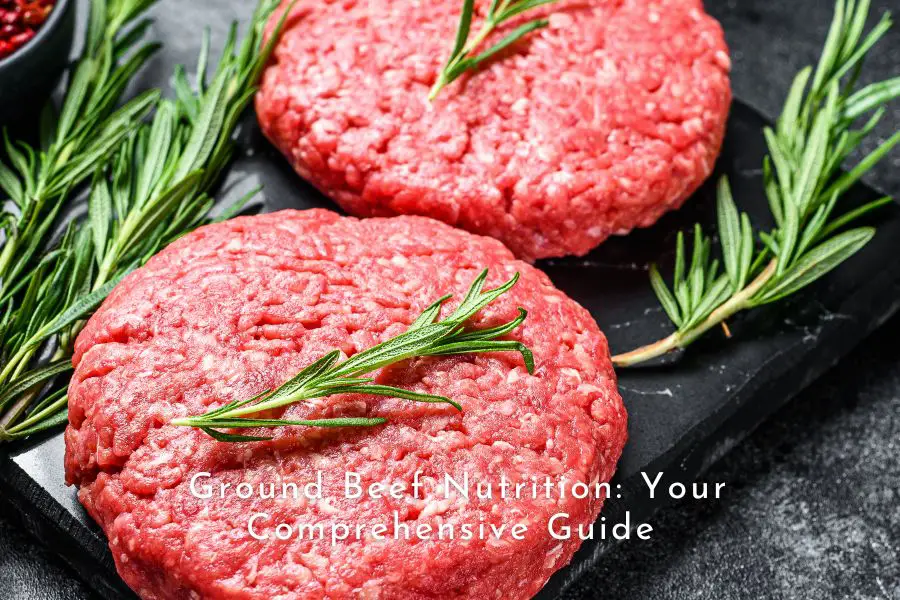Ground beef is a nutritious, affordable and staple ingredient in a myriad of dishes, from classic burgers, meatloaf, meatballs, meat pies to quiche. In this comprehensive guide, we delve into the world of ground beef, exploring its nutritional content, uncovering the health benefits associated with its consumption, and addresses all common questions and concerns regarding ground beef.
What Is Ground Beef?
Ground beef (also called beef mince in some regions) is a meat product made from beef that has been finely minced or ground using a meat grinder or food processor.
Ground beef is typically made from trimmings that can’t be packaged and sold separately on their own like steaks, roast, chops, ribs, etc. In the US, in addition to meat and fat trimmings, other components like esophagus, diaphragm, cheek, heart, and tongue are also permitted in ground beef. In addition, there are also ground beef made from grinding specific primal cuts like “ground chuck”, “ground sirloin”, or “ground round”. [1]
The labeling of ground beef often indicates the fat content as a percentage, such as “80/20,” denoting that the ground beef consists of 80% lean meat and 20% fat. Typically, the leaner the ground beef, the more vibrant cherry red its appearance. According to current US regulations, the maximum allowable fat content in any ground beef is 30% (70% lean). In addition, for a product to be labeled as ground beef, no additional elements like water, phosphates, binders, or other meat sources may be added. [2]
Nutrition in Ground Beef
Ground beef is probably the most affordable and healthy food that you can eat on the carnivore diet. Even though it is a lot cheaper than premium beef cuts like rib-eye, t-bone, porterhouse, and brisket, it is just as nutritious, if not more so, than those premium cuts.
As mentioned above, ground beef can be made from different cuts of meat with very different fat to lean meat ratios, and as a result, the nutritional content of ground beef can vary significantly depending on specific samples tested.
Below is an example of what you might find in a 100-gram (3.5-oz) serving of ground beef with 80% lean meat and 20% fat: [3]
- Calories: 254 calories
- Protein: 17.2 grams
- Fat: 20 grams
- Calcium: 18 mg or 1% of DV
- Iron: 1.9 mg or 11% of DV
- Potassium: 270 mg or 6% of DV
- Phosphorus: 158 mg or 3% of DV
- Sodium: 66 mg or 3% of DV
- Zinc: 4.2 mg or 38% of DV
- Copper: 0.06 mg or 7% of DV
- Selenium: 15 mcg or 27% of DV
- Vitamin B1 (thiamine): 0.04 mg or 4% of DV
- Vitamin B2 (riboflavin): 0.15 mg or 12% of DV
- Vitamin B3 (niacin): 4.2 mg or 26% of DV
- Vitamin B5: 0.5 mg or 10% of DV
- Vitamin B6: 0.32 mg or 19% of DV
- Vitamin B9 (folate): 7 mcg or 2% of DV
- Choline: 56.4 mg or 10% of DV
- Vitamin B12: 2.1 mcg or 89% of DV
- Vitamin E: 0.17 mg or 1% of DV
- Vitamin D: 0.1 mcg or 1% of DV
- Vitamin K: 1.8 mcg or 2% of DV.
The leaner the ground beef, the greater its vitamin and mineral content. For instance, a 100-gram serving of ground beef containing 90% lean meat and 10% fat provides 92% of the RDA for zinc, surpassing the 89% RDA offered by an equivalent serving of ground beef with 80% lean meat and 20% fat. [4, 5]
In addition, if you happen to get a ground beef that has organ meat (the most nutrient-dense food you can eat) as well, its nutritional content can be even higher. As noted earlier, in the US, organ components like esophagus, diaphragm, cheek, heart, and tongue are allowed in ground beef. [6]
In contrast, markets like Australia and the UK permit only muscle meat in ground beef. Nevertheless, you can always request your local butcher to incorporate a small amount of organ meat into the mince, further increasing the nutrient density of your ground beef.
Health Benefits of Eating Ground Beef
Ground beef offers several health benefits, in particular: [7, 8, 9, 10, 11, 12, 13, 14, 15, 16, 17, 18]
- Quality Protein: Ground beef is a rich source of high-quality protein, essential for muscle growth, repair, and overall bodily functions. As proteins in ground beef are complete protein, it provides all the essential amino acids required by the body.
- Nutrient-Rich: Ground beef is a good source of essential nutrients like iron, zinc, vitamin B12, and selenium. These nutrients are crucial for various bodily functions, including immune support, red blood cell production, and DNA synthesis.
- Source of Vitamin B12: Ground beef is one of the best sources of vitamin B12. As shown above, just a 100-gram serving of ground beef delivers 89% of RDA for vitamin B12 which is crucial for the formation of healthy red blood cells, maintaining a healthy nervous system, brain function, DNA synthesis, and energy production.
- Source of Zinc: Ground beef contains a high level of zinc. A 100-gram serving of ground beef delivers 38% of daily value for zinc. Zinc is essential for various biological processes, including immune function, DNA synthesis, wound healing, reproductive health, and skin health, making it a vital micronutrient for overall health.
- Heme Iron: Ground beef is a rich source of heme iron, which is highly absorbable by the body and can be particularly beneficial for individuals at risk of iron deficiency anemia. Heme iron is critical for healthy blood as it is used to make red blood cells which carry oxygen around the body.
- Healthy Fats: Ground beef is low in inflammatory PUFAs and high in beneficial saturated fats, making it a superior choice compared to commercial chicken and pork. You can choose fatter or leaner ground beef depending on your preferences and weight goals.
- Satiety: The protein and fat content in ground beef can contribute to feelings of fullness and satisfaction, helping control appetite and reducing the likelihood of overeating. As a result, like other food on the carnivore diet, ground beef is a great choice for helping you lose fat and maintain a healthy weight.
Best Ground Beef to Eat on the Carnivore Diet
In our opinion, grass-fed and organic ground beef with a high fat content (with 20% to 30% fat and 70% to 80% lean meat) is the best option because it is more nutritious than grain-fed ground beef and has a great fat-to-protein ratio while likely to contain a lower level of contaminant.
However, if you can’t afford grass-fed or organic ground beef, grain-fed ground beef is still an excellent food choice, especially when compared to commercial pork, factory chicken, or farmed fish.
Best Way to Cook Ground Beef
We think the best way for preparing ground beef on the carnivore diet is to shape it into burger patties and cook them to medium or medium rare. This cooking approach preserves the fat and juice content, resulting in a more tasty meat compared to well-cooked burger patties or browned ground beef, which can become tough and dry due to the loss of fat content.
However, this is only safe if you can get your ground beef from reliable sources (e.g. asking your butcher to make ground beef for you from whole meat cuts). If you are not sure about the safety of the ground beef you get, it’s better to cook it to a minimum internal temperature of 160°F (71°C) to kill harmful bacteria.
Ground Beef FAQs
1. Is organic or grass-fed ground beef a healthier option?
Organic and grass-fed ground beef are often considered healthier options compared to conventional grain-fed beef due to several factors, including:
- Healthier Fat Profile: Grass-fed beef typically has a more favorable omega-3 to omega-6 fatty acid ratio. It contains higher levels of omega-3 fatty acids, which are considered heart-healthy, and lower levels of omega-6 fatty acids, which in excess can contribute to inflammation.
- No Antibiotics or Hormones: Organic and grass-fed beef is often produced without the use of antibiotics and growth hormones, which can be a concern for some people. These substances are used less frequently in organic and grass-fed cattle farming.
- Fewer Pesticides and Synthetic Chemicals: Organic beef is produced without synthetic pesticides and herbicides which may be important if you want to reduce your exposure to such substances.
- Improved Animal Welfare: Organic and grass-fed cattle are typically raised under more humane and natural conditions, with free access to pasture and outdoor spaces.
- Environmental Considerations: Grass-fed and organic beef production often come from regenarative farms or those with more sustainable farming practices and hence has a lower environmental impact.
2. What is the fat content in ground beef
The fat content in ground beef can vary based on the cut of meat and the lean-to-fat ratio. The labeling typically indicates the percentage of lean meat, with the rest being fat. Here are common categories:
- Regular Ground Beef: This category may contain a mix of cuts, and the fat content can vary widely. It’s typically around 70-80% lean and 20-30% fat, resulting in approximately 70-80% of calories from fat and 20-30% from protein.
- Ground Sirloin: Generally considered one of the leanest options, ground sirloin typically has a lower fat content, often around 90-95% lean. This results in approximately 50-60% of calories from fat and 40-50% from protein.
- Ground Chuck: With a moderate fat content, usually around 80% lean, ground chuck has a fat-to-protein ratio of approximately 70:30 in terms of calories.
- Ground Round: Leaner than ground chuck but not as lean as ground sirloin, ground round is typically around 85-90% lean.
3. Can I mix ground beef with other types of ground meat like pork or turkey?
Absolutely, mixing ground beef with other types of ground meat like pork, chicken, or turkey is a common practice and can vary the flavors of your dishes.
4. Are there any health concerns associated with ground beef consumption?
Consuming ground beef is generally safe and nutritious, but there are some health concerns to consider:
- Bacterial Contamination: Ground beef can be a source of harmful bacteria such as E. coli and Salmonella. To reduce the risk of foodborne illness, it’s crucial to cook ground beef thoroughly to an internal temperature of at least 160°F (71°C) and handle it safely to avoid cross-contamination.
- Additives: Some commercially available ground beef may contain additives, such as preservatives, fillers or artificial flavors. Choosing minimally processed, high-quality ground beef can help minimize exposure to these additives.
5. What is the best way to thaw frozen ground beef?
There are several safe methods for thawing frozen ground beef:
- Refrigerator: Place the frozen ground beef in a dish or on a plate and thaw it in the refrigerator. This method takes some time, typically requiring several hours or overnight, but it ensures a safe and even thawing process.
- Cold Water Bath: Seal the frozen ground beef in a leak-proof plastic bag and submerge it in cold water. Change the water every 30 minutes to maintain its cold temperature. This method is faster than the refrigerator but still takes a few hours.
- Microwave: Use the defrost setting on the microwave to thaw the ground beef. Be cautious and follow the microwave’s instructions to prevent partial cooking. Thawing in the microwave is quicker but may result in uneven thawing.
It’s important to note that ground beef should never be left uncovered on the kitchen bench and thawed at room temperature, as this increases the risk of bacterial growth and health risk.
6. What is the fastest way to thaw frozen ground beef?
The fastest way to thaw frozen ground beef is to use a sharp knife, slice the frozen chunk into thin sections, place them in the microwave oven, and follow the microwave’s instructions to thaw the ground beef.
7. Can ground beef be refrozen after it has been thawed?
Generally, it is not recommended to refreeze ground beef once it has been thawed. When you thaw meat, moisture is released, and bacteria that may have been present can multiply. Refreezing the meat can lead to a decline in quality and safety, as some frost-proof bacteria may have the opportunity to multiply and survive during the refreezing process. If you’ve thawed ground beef and decide not to use it all, it’s better to cook the entire portion and then freeze the cooked meat. This way, you can safely store the leftovers for later use without compromising quality or safety.
However, some people believe that if you thaw your ground beef slowly in the fridge and your fridge has been kept at a safe temperature, it is perfectly fine to refreeze it again.
8. How Long Can Ground Beef Stay Fresh in the Fridge
The freshness of ground beef in the fridge depends on various factors, including the temperature of your refrigerator, the initial quality of the meat, and how well it’s packaged. In general, raw ground beef can be stored in the refrigerator for 1-2 days before its quality starts to decline.
If you want to extend the freshness:
- Refrigerator Temperature: Ensure your refrigerator is set at or below 40°F (4°C) to slow down bacterial growth and maintain freshness.
- Packaging: Keep the ground beef in its original packaging, and if possible, place it in a sealed container or resealable bag to prevent cross-contamination and exposure to air.
- Use-By Date: Pay attention to the use-by or expiration date on the packaging. Consume the ground beef before this date for the best quality.
For longer storage, you can freeze ground beef. When stored in the freezer at 0°F (-18°C) or lower, ground beef can last for 3-4 months or even longer while maintaining good quality.
9. How to Know If Your Ground Beef Is Bad
Detecting whether ground beef has gone bad involves using your senses and observing certain characteristics. Here are signs that ground beef may be spoiled:
- Color: Fresh ground beef is typically bright red. If it has turned brown or gray, it might indicate spoilage. However, it’s essential to note that sometimes the interior of the meat may still be safe to eat even if the exterior has changed color.
- Smell: A sour or unpleasant odor is a strong indicator of spoilage. Fresh ground beef should have a neutral, meaty smell. If it smells off or foul, it’s best not to consume it.
- Texture: Fresh ground beef has a relatively soft and moist texture. If it feels slimy or excessively sticky, it might be a sign of bacterial growth and spoilage.
- Expiry Date: Check the use-by or expiration date on the packaging. If the ground beef is well past this date, it’s safer not to consume it.
- Packaging: If the packaging is swollen, leaking, or damaged, it could indicate that the ground beef has been exposed to air and bacteria, leading to spoilage.
- Visual Mold: Any presence of mold on the ground beef is a clear sign of spoilage. Discard the meat if you see any visible mold growth.
10. Is it safe to eat ground beef that has turned brown?
Ground beef can turn brown if it is exposed to oxygen over time, but it doesn’t necessarily mean the meat is unsafe to eat.
If the ground beef has turned brown but has been stored properly and doesn’t smell off, it is still perfectly fine to eat.
However, if it has turned brown as well as has an off or unpleasant odor, or if the texture feels slimy or excessively sticky, it may indicate spoilage. In such cases, it’s better to discard the meat.
If in doubt, cooking ground beef thoroughly to an internal temperature of 160°F (71°C) or more can help kill any bacteria that may be present, reducing the risk of food-borne illness.
11. What are safe internal temperatures for cooking ground beef to prevent food-borne illness?
According to the United States Department of Agriculture (USDA), ground beef needs to be cooked to a minimum internal temperature of 160°F (71°C). This temperature ensures the destruction of harmful bacteria, such as E. coli and Salmonella.
12. How can I prevent cross-contamination when handling raw ground beef?
Here are some tips to help you minimize the risk of cross-contamination when handling raw ground beef:
- Hand Hygiene: Wash your hands thoroughly with soap and water before and after handling raw ground beef. This helps prevent the spread of bacteria from the meat to other surfaces or foods.
- Separation: Keep raw ground beef separate from ready-to-eat foods and use different cutting boards, utensils, and plates for raw meat to avoid contact with other foods.
- Clean Surfaces: Clean and sanitize all surfaces, utensils, and cutting boards that come into contact with raw ground beef. Use hot, soapy water and a sanitizing solution to eliminate bacteria.
- Storage: Store raw ground beef in sealed containers or plastic bags on a plate or tray to prevent any drips or leaks. Keep it in the refrigerator at or below 40°F (4°C) and use or freeze it within a few days of purchase.
- Defrost Safely: If thawing frozen ground beef, do so in the refrigerator, not on the countertop. This ensures a controlled environment and reduces the risk of bacterial growth.
13. Can You Eat Medium Rare Ground Beef?
It may not be safe to eat medium rare ground beef. Ground beef poses a higher risk of food-borne illness compared to whole cuts of meat because the grinding process can introduce bacteria from the surface of the meat throughout the entire batch. Therefore, it is generally recommended to cook ground beef thoroughly to a minimum internal temperature of 160°F (71°C) to ensure food safety.
14. How can I make lean ground beef taste more flavorful?
Two tips to make lean ground beef taste more flavorful are:
- Use a variety of herbs and spices to add depth of flavor. Common choices include garlic powder, onion powder, cumin, paprika, chili powder, oregano, thyme, and rosemary. Experiment with different combinations to find what you like.
- Avoid overcooking your ground beef because it will render out most of the fat resulting in dry and and unappetizing meat. Cook it just enough to maintain juiciness and flavor.
- Use high heat to brown the outside of your meatballs or burger patties. The Maillard reaction help produce extra flavour and aroma for the meat.
15. What is the difference between ground beef and hamburger meat?
Ground beef and hamburger are essentially the same in that they both consist of meat and fat trimmings or ground meat of primal cuts. The key difference between the two is that ground beef cannot include additional beef fat in the mix, whereas hamburger can, provided it does not surpass 30 percent total fat. Hamburger may also include seasonings, but it is not allowed to contain water, phosphates, extenders, or binders.
16. How can I reduce the fat content in ground beef dishes?
Two ways to reduce the fat content of your ground beef dishes are:
- Choose Leaner Cuts: Start with lean ground beef with 90-95% lean meat or ground beef made from lean primal cuts such as ground sirloin
- Drain and Rinse: Brown ground beef well and after browning, drain excess fat. You can also rinse the cooked meat under hot water to remove additional fat.
17. Can You Eat Raw Ground Beef
I’ve seen people eating raw ground beef but it is generally not considered a safe practice. As mentioned earlier, the grinding process can introduce bacteria from the surface of the meat throughout the entire batch. Consequently, there are potential health risks associated with eating raw ground beef, as it may harbor harmful bacteria such as E. coli and Salmonella, leading to food-borne illnesses.
Other posts you might be interested in:
What Is the Best Meat to Eat on the Carnivore Diet?
Carnivore vs Low-Carbs vs Moderate-Carbs vs High-Carbs
Best Sources of Carbohydrates On a Meat-Based Diet
Is Carnivore the Best Anti-Aging Diet Around?
How to Carnivore Diet While Traveling
11 Common Carnivore Diet Mistakes
Disclaimer: The information in this post is for reference purposes only and is not intended to constitute or replace professional medical advice. Please consult a qualified medical professional before making any changes to your diet or lifestyle. Please check out our disclaimer for more detail.





